Low-Noise, Narrow Linewidth Laser System, 1310 nm

- High-Power, Turnkey, Single-Frequency Laser System at 1310 nm
- Low-Noise Drive Electronics to Minimize RIN and Linewidth
- 20 MHz Current Modulation Bandwidth
- Linewidths as Low as 100 kHz Available
DFB13TK
Narrow-Linewidth, Low-Noise Laser System, 1310 nm
The frequency noise spectral density gives a Lorentzian linewidth of 106 kHz for the DFB13TK.

Please Wait
| Key Specifications | |
|---|---|
| Item # | DFB13TK |
| Typical Linewidth | 100 kHz |
| Typical RIN | -150 dBc/Hz |
| Mode-Hop-Free Single-Frequency Operating Current Region |
Continuousa |
| Temperature Tuning Range | 1.6 nmb |
| AC Modulation Wavelength Tuning Range | ±0.15 nm |
| DC Modulation Wavelength Tuning Range | ±0.03 nm |
Applications
- Optical Reference Laser
- LIDAR/LADAR
- Fiber Optic Sensing
- Quantum Optics
- Atomic Clocks
- Rubidium Cooling
Features
- High-Power Turnkey Single-Frequency Laser System in the O-Band
- Distributed Feedback (DFB) Laser System:
- 100 kHz Typical Linewidth, 50 dB Typical Side-Mode Suppression Ratio (SMSR)
- Relative Intensity Noise (RIN) of -150 dBc/Hz
- Continuous Mode-Hop-Free Operating Current Region
- Temperature Tuning Range of 1.6 nm
- Low-Noise Drive Electronics to Minimize RIN and Linewidth
- Analog Modulation Inputs for DC Current, AC Current, and Laser Temperature
- Integrated Isolator to Minimize Effects of Back-Reflected Light
- Remote Operation and Set-Point Adjustment with Command-Line Interface via USB 2.0

Click to Enlarge
The DFB13TK laser can be mounted to an optical table using four 1/4"-20 cap screws. The DFB13TK is pictured with a P3-1310PM-FC-5 PM fiber patch cable and three CA2912 SMA cables, which are connected to the optical output and analog modulation ports, respectively.
Thorlabs' single-frequency, turnkey, low-noise laser system at 1310 nm is a ready-to-use laser system that integrates a distributed feedback (DFB) diode with a low-noise driver inside of a benchtop housing. To minimize the laser linewidth and relative intensity noise (RIN), this laser includes drive electronics that are designed to minimize the current noise. An isolator is integrated at the output of the laser to minimize the impact of any back-reflected light on the laser.
The DFB13TK laser uses a DFB diode, which incorporates a grating structure along the length of the gain medium of the laser chip, providing single-frequency emission with typical relative intensity noise (RIN) of -150 dBc/Hz and typical linewidths of 100 kHz. Factory-set for optimized performance, this laser offers a minimum output power of 100 mW with a side-mode suppression ratio (SMSR) of 50 dB. This design allows for a broad, mode-hop-free, single-frequency operation range (50 mA to 500 mA). The DFB13TK laser system can also be tuned by adjusting the current or the temperature of the laser chip, with a mode-hop-free temperature tuning range of up to 1.6 nm.
This laser is designed with laser frequency locking applications in mind. The system comes equipped with two analog current modulation ports (DC and AC coupled) and an analog temperature modulation port. These modulation inputs can be used to lock the laser frequencies to optical cavities or referenced using servo electronics in order to build stable laser systems.
The optical output of this laser is fiber-coupled via FC/APC bulkhead (2.0 mm narrow key) output connectors. For best performance, we recommend connecting our PM FC/APC fiber patch cables that contain PM1300-XP fiber, such as the P3-1310PM-FC-1 patch cable. Note that the polarization axis is aligned with the narrow key of the bulkhead connector.
The systems are powered by a 12 VDC, 4 A input. A DS12 power supply is provided with each laser; see the Shipping List tab for a complete list of items included with the device.
Thorlabs also offers the DFB15TK, a similar low-noise, DFB system at 1550 nm, as well as the ULN15TK ultra-low-noise laser system with typical linewidths of 100 Hz.
Single-Frequency Operation and Wavelength Tuning
Factory-set for single-frequency operation, this laser has a preset drive current and temperature. When the laser is enabled using the push-button switch on the front panel (see Front & Back Panels tab), the laser operates at the preset current level. Each laser is shipped with a test data sheet taken at the preset operating conditions; click here for a sample data sheet. These datasheets can also be downloaded by clicking on the red Docs icon (![]() ) next to the Item # and entering your device's serial number under "Download Serial Item Data."
) next to the Item # and entering your device's serial number under "Download Serial Item Data."
The user can adjust the operating current either by sending a command through USB communication (see Remote Operation below) or by applying small modulation to the current through one of the modulation ports on the front panel of the system (see Analog Modulation below). Adjusting the operating current results in both a change in the output power but also a change in the laser wavelength. In addition to the operating current, the laser chip temperature is also adjustable either through the command-line interface (USB) or the front-panel modulation port. The temperature changes are primarily useful for tuning the laser wavelength while maintaining a relatively constant output power. See the Specs tab for more information on current and temperature tuning of these lasers.
Analog Modulation
By controlling the laser's drive current or temperature, the laser's wavelength can be tuned free of mode-hopping within a small range around its set-point. Three analog modulation ports (SMA Female) are included on the front panel (see the Front & Back Panels tab). Two of the ports allow the laser current to be modulated by ±10 mA around the current set point: of these, the port labelled "AC Current" can support modulation frequencies from 2 kHz to 20 MHz, and the port labelled "DC Current" accepts frequencies from DC to 5 MHz. The third port, which is labelled "Temp", controls the chip temperature and accepts modulation frequencies from DC to 1 Hz. To see how the laser wavelength can be tuned around its set-point, please see the wavelength tuning plots provided in the Graphs tab.
Each modulation port accepts a -5 V to 5 V input signal. To convert the modulation voltage into a current or temperature change, see the Specs tab.
Remote Operation
Remote operation is also possible by connecting the laser to a PC (not included) via the USB port on the back of the unit and using a command line interface. In addition to basic functions such as turning the laser on and off or reading status indicators, the command line enables the user to modify the laser operating set-points. The full list of commands can be found in the laser manual. A USB-AB-72 USB 2.0 Type-A to Mini-B Cable is included with each device.
Adjusting the laser parameters (operating current and temperature) can be used for tuning the laser power or wavelength. Typical performance plots that demonstrate the laser's center wavelength tuning and the single-mode operating regions can be found on the Graphs tab. Please note that specific performance data is provided on the datasheet shipped with each device.
A 9-Pin male D-Sub connector is also included on the back panel of the system for RS-485 communication protocol. Please refer to the Pin Diagrams tab for the pin assignment of the connector.
Mounting
For mounting to an optical table, the compact housing of this benchtop DFB laser features four clearance holes each for M6 or 1/4" cap screws.
| Item # | DFB13TK |
|---|---|
| Laser Specificationsa | |
| Center Wavelengthb | 1310 nm ± 5 nm |
| Output Powerc | ≥100 mW |
| Linewidthd | <200 kHz (Typ. 100 kHz) |
| Relative Intensity Noise (RIN)e | -150 dBc/Hz |
| Side-Mode Suppression Ratio (SMSR)f | >35 dB (Typ. 50 dB) |
| Polarization Extinction Ratio (PER) | 25 dB |
| Output Isolation | 25 dB |
| Mode-Hop-Free Operating Currentg | 50 mA to 500 mA |
| Mode-Hop-Free Power Range | 15 mW to 100 mW |
| Slope Efficiency | 0.27 W/A |
| Threshold Current | 15 mA |
| Current Tuning Coefficient | 0.003 nm/mA |
| Laser Chip Temperature Tuning Coefficient | 0.08 nm/°C |
| Laser Chip Temperature Tuning Range | 15 °C to 35 °C |
| Temperature Tuning Rangeh | 1.6 nm |
| Fiber Specifications | |
| Output Fiber Typei | PM1300 |
| Output Fiber Connectors | FC/APC Compatible, 2.0 mm Narrow Key |
| External Modulation Specifications | |
| AC Voltage to Current Conversion Rate | 10 mA/V |
| AC Laser Wavelength Tuning Range | ±0.15 nm |
| AC Laser Power Tuning Range | ±10 mW |
| DC Voltage to Current Conversion Rate | 2 mA/V |
| DC Laser Wavelength Tuning Range | ±0.03 nm |
| DC Laser Power Tuning Range | ±1 mW |
| Voltage to Temperature Conversion Rate | Firmware Adjustable (Default = 0.2 °C/V) |
| Input Voltage Range (All Ports) | -5 V to 5 V |
| Input Impedance (All Ports) | 1 kΩ |
| AC Current Modulation Frequency Rangej | 2 kHz to 20 MHz |
| DC Current Modulation Frequency Rangej | DC to 5 MHz |
| Temperature Modulation Frequency Range | DC to 1 Hz |
| Absolute Maximum Ratings | |
|---|---|
| Absolute Maximum Output Power | 145 mW |
| Operating Temperature | 15 °C to 35 °C |
| Storage Temperature | -10 °C to 40 °C |
| General Specifications | |
|---|---|
| Input Voltage | 12 V (from DS12 Power Supply) |
| Input Power | 20 W (Max) |
| Dimensions (W x D x H) | 10.00" x 5.31" x 2.94" (254.0 mm x 135.0 mm x 74.6 mm) |
| Weight | 4.7 lbs (2.1 kg) |
| Laser Class | 1M |
The plots below represent the relative intensity noise (RIN) and frequency noise for the DFB13TK laser system.

Click to Enlarge
Click Here for Data
Example frequency noise data for the DFB13TK laser system operated at the factory-set conditions.

Click to Enlarge
Click Here for Data
The typical low-frequency relative intensity noise (RIN) for a DFB13TK laser system operated at the factory-set conditions.
The plots below represent the typical performance of the DFB13TK low-noise laser system. Specific performance data is provided on the datasheet shipped with each device; click here for a sample data sheet.
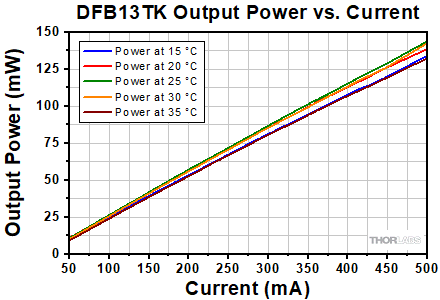
Click to Enlarge
Click Here for Data
Example output power vs. current data for a DFB13TK laser system operated at factory-set conditions. The DC current set-point is adjustable up to 450 mA, while the AC modulation port can add up to 50 mA of additional current modulation for access to the entire 50 mA to 500 mA mode-hop-free operating current range.
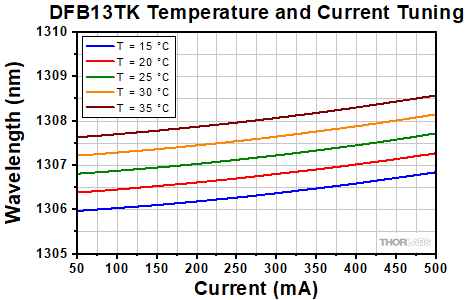
Click to Enlarge
Click Here for Data
Example temperature and current tuning for a DFB13TK laser system operated at the factory-set conditions. The DC current set-point is adjustable up to 450 mA, while the AC modulation port can add up to 50 mA of additional current modulation for access to the entire 50 mA to 500 mA mode-hop-free operating current range.
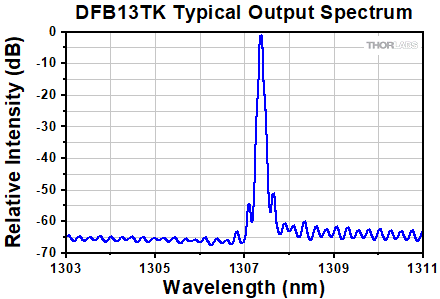
Click to Enlarge
Click Here for Data
The typical spectrum for a DFB13TK laser system operated at the factory-set conditions. This measurement was taken using an optical spectrum analyzer with a spectral resolution of 0.02 nm.
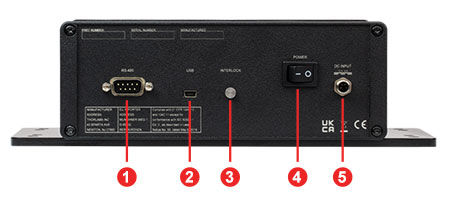
Click to Enlarge
DFB13TK Turnkey DFB Laser Back Panel
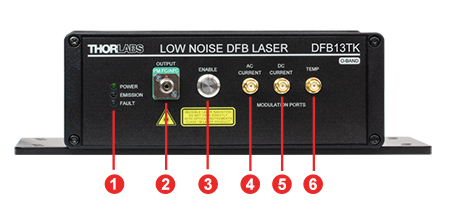
Click to Enlarge
DFB13TK Turnkey DFB Laser Front Panel
| Front Panel | |
|---|---|
| Call Out | Description |
| 1 | Status Indicator LEDs |
| 2 | Laser Output Port (FC/APC, 2.0 mm Narrow Key, PM Fiber Output) |
| 3 | Laser Enable Push-Button Switch |
| 4 | AC Current Modulation Input (SMA Female) |
| 5 | DC Current Modulation Input (SMA Female) |
| 6 | Temperature Control Modulation Input (SMA Female) |
| Back Panel | |
|---|---|
| Call Out | Description |
| 1 | RS-485 Communication (DB-9 Male) |
| 2 | USB Communication (USB Mini-B) |
| 3 | Remote Interlock Pin (2.5 mm Mono Phono Female) |
| 4 | Power Switch |
| 5 | DC Input (M8 Connector for the DS12 Power Supply) |
DFB13TK Pin Diagrams
USB 2.0 Communication
USB Mini-B
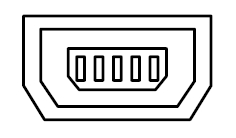
Input for Analog Modulation
SMA Female

Input Voltage: -5 V to 5 V
Input Impedance: 1 kΩ
AC Current Modulation Frequency Range: 2 kHz to 20 MHz*
DC Current Modulation Frequency Range: DC to 5 MHz*
*The specified bandwidth refers to the 3 dB electrical bandwidth of the modulation circuits. The laser response has a slow roll-off for frequencies above 1 MHz.
RS-485 Communication
9-Pin Male D-Sub Connector 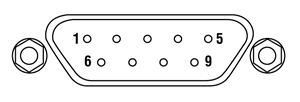
| Pin Assignment | |
|---|---|
| Pin | Output Signal |
| 1 | RS-485 Half-Duplex T/R+ |
| 2 | RS-485 Half-Duplex T/R- |
| 3 | Not Connected |
| 4 | Not Connected |
| 5 | Ground |
| 6 | Not Connected |
| 7 | Ground |
| 8a | Do Not Connect |
| 9a | Do Not Connect |
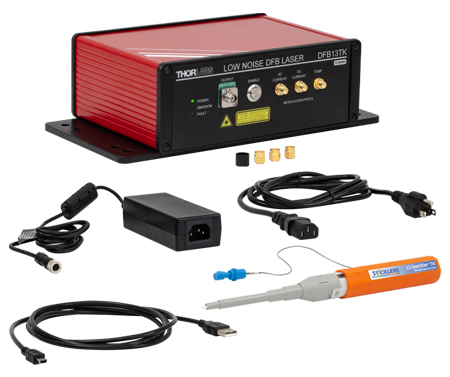
Click to Enlarge
DFB13TK Laser System and Accessories
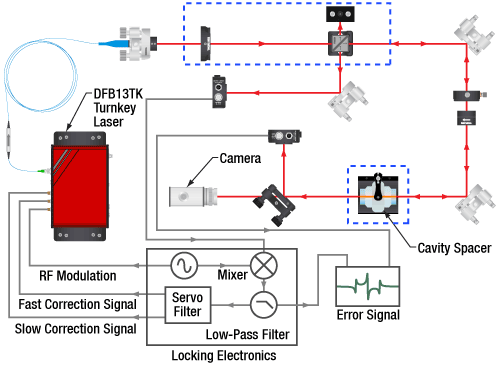
Click for Details
Experimental Setup for Laser Stabilization
Laser Stabilization
The DFB13TK turnkey, low noise laser offers exceptional optical spectral purity and is configured for out-of-the-box use with little setup effort. However, for the most demanding applications, such as optical clocks and high-resolution spectroscopy, active electronic feedback may be required to further suppress technical noise and drifts. This turnkey laser conveniently provides multiple high-bandwidth analog modulation ports for locking to external optical references such as an optical cavity or an atomic/molecular transition.
In the figure to the right, we show an example of how the Pound-Drever-Hall (PDH) locking scheme is used to lock the DFB13TK laser to a reference cavity comprised of mirrors with a crystalline coating attached to an ultra-low expansion glass spacer. The RF modulation input conveniently permits the PDH sidebands to be generated without an external optical modulator. Demodulation of the reflected signal from the cavity yields an error signal which can be processed with a servo filter to maintain resonance with the optical cavity. This turnkey laser provides a high-bandwidth DC-coupled current modulation port to correct for fast fluctuations, and a slower temperature modulation port with larger range to correct for slower drifts.
ECL, DFB, VHG-Stabilized, DBR, and Hybrid Single-Frequency Lasers
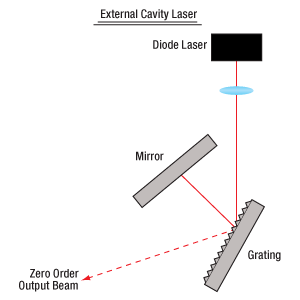
Click to Enlarge
Figure 1: ECL Lasers have a Grating Outside of the Gain Chip
A wide variety of applications require tunable single-frequency operation of a laser system. In the world of diode lasers, there are currently four main configurations to obtain a single-frequency output: external cavity laser (ECL), distributed feedback (DFB), volume holographic grating (VHG), and distributed Bragg reflector (DBR). All four are capable of single-frequency output through the utilization of grating feedback. In addition, an ECL can be combined with a fiber Bragg grating (FBG) to create a hybrid design. However, each type of laser uses a different grating feedback configuration, which influences performance characteristics such as output power, tuning range, and side mode suppression ratio (SMSR). We discuss below some of the main differences between single-frequency diode lasers.
External Cavity Laser
The External Cavity Laser (ECL) is a versatile configuration that is compatible with most standard free space diode lasers. This means that the ECL can be used at a variety of wavelengths, dependent upon the internal laser diode gain element. A lens collimates the output of the diode, which is then incident upon a grating (see Figure 1). The grating provides optical feedback and is used to select the stabilized output wavelength. With proper optical design, the external cavity allows only a single longitudinal mode to lase, providing single-frequency laser output with high side mode suppression ratio (SMSR > 45 dB).
One of the main advantages of the ECL is that the relatively long cavity provides extremely narrow linewidths (<1 MHz). Additionally, since it can incorporate a variety of laser diodes, it remains one of the few configurations that can provide narrow linewidth emission at blue or red wavelengths. The ECL can have a large tuning range (>100 nm) but is often prone to mode hops, which are very dependent on the ECL's mechanical design as well as the quality of the antireflection (AR) coating on the laser diode.
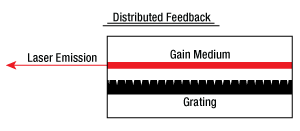
Click to Enlarge
Figure 2: DFB Lasers Have a Bragg Reflector Along the Length of the Active Gain Medium
Distributed Feedback Laser
The Distributed Feedback (DFB) Laser (available in NIR and MIR) incorporates the grating within the laser diode structure itself (see Figure 2). This corrugated periodic structure coupled closely to the active region acts as a Bragg reflector, selecting a single longitudinal mode as the lasing mode. If the active region has enough gain at frequencies near the Bragg frequency, an end reflector is unnecessary, relying instead upon the Bragg reflector for all optical feedback and mode selection. Due to this “built-in” selection, a DFB can achieve single-frequency operation over broad temperature and current ranges. To aid in mode selection and improve manufacturing yield, DFB lasers often utilize a phase shift section within the diode structure as well.
The lasing wavelength for a DFB is approximately equal to the Bragg wavelength:

where λ is the wavelength, neff is the effective refractive index, and Λ is the grating period. By changing the effective index, the lasing wavelength can be tuned. This is accomplished through temperature and current tuning of the DFB.
The DFB has a relatively narrow tuning range: about 2 nm at 850 nm, about 4 nm at 1550 nm, or at least 1 cm-1 in the mid-IR (4.00 - 11.00 µm). However, over this tuning range, the DFB can achieve single-frequency operation, which means that this is a continuous tuning range without mode hops. Because of this feature, DFBs have become a popular and majority choice for real-world applications such as telecom and sensors. Since the cavity length of a DFB is rather short, the linewidths are typically in the 1 MHz to 10 MHz range. Additionally, the close coupling between the grating structure and the active region results in lower maximum output power compared to ECL and DBR lasers.
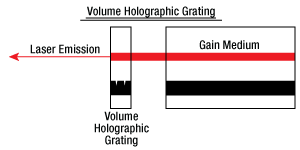
Click to Enlarge
Figure 3: VHG Lasers have a Volume Holographic Grating Outside of the Active Gain Medium
Volume-Holographic-Grating-Stabilized Laser
A Volume-Holographic-Grating-(VHG)-Stabilized Laser also uses a Bragg reflector, but in this case a transmission grating is placed in front of the laser diode output (see Figure 3). Since the grating is not part of the laser diode structure, it can be thermally decoupled from the laser diode, improving the wavelength stability of the device. The grating typically consists of a piece of photorefractive material (typically glass) which has a periodic variation in the index of refraction. Only the wavelength of light that satisfies the Bragg condition for the grating is reflected back into the laser cavity, which results in a laser with extremely wavelength-stable emission. A VHG-Stabilized laser can produce output with a similar linewidth to a DFB laser at higher powers that is wavelength-locked over a wide range of currents and temperatures.
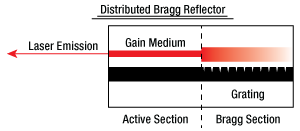
Click to Enlarge
Figure 4: DBR Lasers have a Bragg Reflector Outside of the Active Gain Medium
Distributed Bragg Reflector Laser
Similar to DFBs, Distributed Bragg Reflector (DBR) Lasers incorporate an internal grating structure. However, whereas DFB lasers incorporate the grating structure continuously along the active region (gain region), DBR lasers place the grating structure(s) outside this region (see Figure 4). In general a DBR can incorporate various regions not typically found in a DFB that yield greater control and tuning range. For instance, a multiple-electrode DBR laser can include a phase-controlled region that allows the user to independently tune the phase apart from the grating period and laser diode current. When utilized together, the DBR can provide single-frequency operation over a broad tuning range. For example, high end sample-grating DBR lasers can have a tuning range as large as 30 - 40 nm. Unlike the DFB, the output is not mode hop free; hence, careful control of all inputs and temperature must be maintained.
In contrast to the complicated control structure for the multiple-electrode DBR, a simplified version of the DBR is engineered with just one electrode. This single-electrode DBR eliminates the complications of grating and phase control at the cost of tuning range. For this architecture type, the tuning range is similar to a DFB laser but will mode hop as a function of the applied current and temperature. Despite the disadvantage of mode hops, the single-electrode DBR does provide some advantages over its DFB cousin, namely higher output power because the grating is not continuous along the length of the device. Both DBR and DFB lasers have similar laser linewidths. Currently, Thorlabs offers only single-electrode DBR lasers.
Ultra-Low-Noise Hybrid Laser
Thorlabs Ultra-Low-Noise (ULN) Hybrid Lasers each consist of a single angled facet (SAF) gain chip coupled to an exceptionally long fiber Bragg grating (FBG). They are designed to create a laser cavity, similar to an ECL, through the length of fiber. This cavity provides the ULN hybrid laser with a very narrow line width on the order of 100 Hz and low relative intensity noise of -165 dBc/Hz (typical). The FBG reflects a portion of the light emitted from the gain medium while remaining thermally isolated from it. The grating period can be changed by introducing thermal stress to the fiber, allowing users to temperature tune the laser output while being able to independently stabilize the gain medium's temperature. Because the laser's configuration provides excellent low-noise performance, it is likely the laser will not be the limiting factor at low-noise levels. It is critical to monitor the laser's environment to limit external noise contributions like acoustic and seismic vibrations, as well as driving the laser with a low-noise current source.
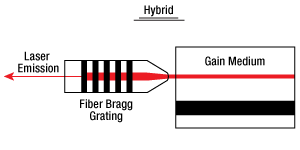
Click to Enlarge
Figure 5: Thorlabs Hybrid Lasers have a Fiber Bragg Grating Coupled to the Active Gain Medium
Conclusion
ECL, DFB, VHG, DBR, and hybrid laser diodes provide single-frequency operation over their designed tuning range. The ECL can be designed for a larger selection of wavelengths than either the DFB or DBR. While prone to mode hops, it provides narrow linewidths (<1 MHz). In appropriately designed instruments, ECLs can also provide extremely broad tuning ranges (>100 nm).
The DFB laser is the most stable single-frequency, tunable laser configuration. It can provide mode-hop-free performance over its entire tuning range (<5 nm), making it one of the most popular forms of single-frequency laser for much of industry. It has the lowest output power due to inherent properties of the continuous grating feedback structure.
The VHG laser provides stable wavelength performance over a range of temperatures and currents and can provide higher powers than are typical in DFB lasers. This stability makes it excellent for use in OEM applications.
The single-electrode DBR laser provides similar linewidth and tuning range as the DFB (<5 nm). However, the single-electrode DBR will have periodic mode hops in its tuning curve.
Hybrid lasers can be used to achieve extremely low-noise signals. In order to take advantage of this characteristic, the laser must be isolated from unwanted noise sources, such as acoustic and seismic vibrations and drive current noise.
| Posted Comments: | |
| No Comments Posted |

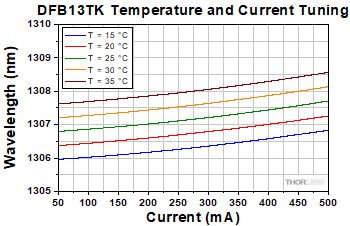
Click to Enlarge
Click Here for Data
Example temperature and current tuning for a DFB13TK laser system operated at the factory-set conditions.
- 100 kHz Typical Lorentzian Linewidth
- -150 dBc/Hz Typical Relative Intensity Noise (RIN)
- Continuous Mode-Hop-Free Single Frequency Operation
- 1.6 nm Temperature Tuning Range
Thorlabs' DFB13TK Turnkey, Low-Noise Distributed Feedback (DFB) Laser System is a ready-to-use laser system that integrates a 1310 nm DFB laser with a low-noise driver inside of a benchtop housing. See the blue info icon (![]() ) in the table below for typical performance specifications. Each DFB laser system is serialized and ships with individual test data; click here for a sample data sheet. These datasheets can also be downloaded by clicking on the red Docs icon (
) in the table below for typical performance specifications. Each DFB laser system is serialized and ships with individual test data; click here for a sample data sheet. These datasheets can also be downloaded by clicking on the red Docs icon (![]() ) next to the Item # and entering your device's serial number under "Download Serial Item Data."
) next to the Item # and entering your device's serial number under "Download Serial Item Data."
The DFB design allows a broad mode-hop-free single-frequency operation region (50 mA to 500 mA), while maintaining a narrow 100 kHz Lorentzian linewidth and a typical relative intensity noise (RIN) of -150 dBc/Hz. Wavelength tuning can be accomplished by adjusting the current or the temperature of the laser chip, with typical temperature tuning of up to 1.6 nm (with the chip temperature adjusted by 20 °C). The DFB13TK will remain single-frequency as the temperature is tuned without the need to simultaneously adjust the current.
The system comes equipped with two analog current modulation ports (AC and DC coupled) and an analog temperature modulation port, which can be used to lock the laser frequency to optical cavities or referenced using servo electronics in order to build stable laser systems. Remote operation is possible by connecting the laser to a PC and using a command line interface.
The optical output of this laser is fiber-coupled via an FC/APC bulkhead (2.0 mm narrow key) output connector. For best performance, we recommend connecting our PM FC/APC fiber patch cables that contain PM1300-XP fiber. Each laser is shipped with a DS12 power supply; see the Shipping List tab for a complete list of items included with the device.
 Products Home
Products Home












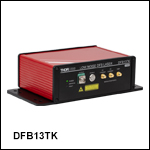
 Zoom
Zoom Low-Noise, Narrow-Linewidth Laser, 1310 nm
Low-Noise, Narrow-Linewidth Laser, 1310 nm